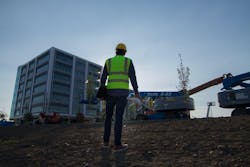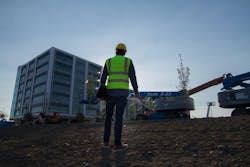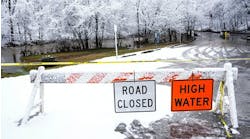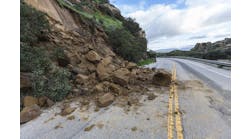By: Tariq Rashid
Outfitted with fluorescent vests and hard hats, construction workers enter jobsites alert to the injuries or fatality-causing hazards that surround them, such as falls from heights, electrocution or being struck by objects. In fact, OSHA’s 2015 statistics for casualties reported 937 total deaths in the construction industry and 364 were caused by falls. Falls represent 39% of deaths in the construction industry, not including highway traffic incidents.
New uses for commercial drones continue to emerge, with construction and engineering leading the pack, and are proving instrumental in decreasing overall risk on the jobsite. Combining a culture of safety, or an investigation of risk, with an organization’s drone program will strengthen operations, further reducing jobsite risks for the company.
Construction drone adoption skyrockets
Drone technology allows construction crews to inspect a damaged roof without relying on ladders or scaffolding, or examine crumbling surfaces with aerial data that is impossible to attain with a boat, not to mention significantly more affordable than using a helicopter. Adding a drone safety program to an organization requires a team to have the knowledge, techniques, and tools that encourage both flight discipline and proactive investigation of possible risk.
In a recent qualitative survey conducted by Blue Research, commissioned by Skyward, research indicates 10% of enterprises with $50 million or more in revenue are using drones, and 35% of those companies work in construction and engineering. Additionally, results concluded that 19% of the professionals surveyed have plans to utilize drones in the future, and of current users, half reported their company’s bottom line would suffer without drones.
Creating a culture of safety
So what exactly is a culture of safety and how can companies develop one to maximize a level of safety? A culture of safety is the result of deeply ingrained knowledge of risk and consistent application of technical and operational methods to control risk.
Breaking it down further, let us consider culture as a consistent observable pattern of behavior in an organization, and safety as the condition of being protected from harm and other non-desirable outcomes. This idea of consistent pattern also can be applied to the practice of making lists and checklists. Operational checklists help organizations using drones establish a pattern of behavior. In fact, the high levels of safety in commercial aviation today are largely a result of technical and operational framework that enable a high degree of repeatability and give way to a culture of accountability.
While checklists and other routine tasks, such as policy training videos and reports, play an important role in operating and sustaining a safe drone operation, and may check off requirements for your organization’s compliance and liability protection, they cannot create a culture of safety in and of themselves. Instead, unmanned aircraft system (UAS) pilots need to possess an underlying belief that operating safely is the only way to sustain a commercial drone operation.
Today’s widespread adoption of drones in construction and engineering stresses that any person looking to establish a culture of safety must constantly seek out knowledge of the risks specific to their operations. A primary failure mode is the first thing that happens which may or may not result in an incident depending on the severity of the failure and the response to it. Estimating the probability of the different types of primary failure modes can come from field experience with equipment and personnel, as well as functional knowledge of the equipment and the operating environment. Though today’s commercial drone aviation lacks operational history needed to precisely calculate probabilities of primary failure modes, experienced operators should be able to classify the likelihood of a specific event as probably, possible or unlikely.
This ability to classify also requires a distinction between primary failure modes and consequences. For example, crashing into a school bus due to drone pilot error is a consequence, whereas losing visual contact with the aircraft can be considered a mode of failure. Of course, the potential for damage or injury will vary based on the job, energy and size of the aircraft, including speed and mass, as well as the presence of hazardous, flammable or sensitive materials surrounding the aircraft. An organization cannot maximize their knowledge of risk without first inspecting every detail possible.
Developing an organization’s culture of safety also requires operational risk management, or in other words, a framework that structures the pursuit of knowledge of risk. As companies seek opportunities to incorporate risk-mitigating best practices, it is important to stay focused, but not let risk management compromise the value that a commercial drone program offers the organization. While the best safety measures will prevent accidents, they also will support operational efficiency that allows the organization to meet deadlines and control project costs.
Structuring operational risk management
One of the best approaches to structuring operational risk management is to group potential hazards into the following categories:
- Job hazards: Is the company, or more specifically the crew, familiar with this type of job? Another way to approach it: Is there any risk of an open-ended flight without clear goals or limits as a result of a poorly specified job?;
- Airspace hazards: Is the flight located within 3 nautical miles of an airport or 1 nautical mile of a heliport, posing a risk for collision with a manned aircraft at lower altitudes? Also, perhaps the flight will take place over railroads, rivers or other commonly used navigational features;
- Site hazards: Consider any obstructions within 100 ft of the intended flight path—overhead wires, dust, smoke or heavy vehicle traffic could impact drone flight;
- Aircraft hazards: Are both the company and crew familiar with the aircraft required for the job? The job may call for the aircraft to be operated near performance limits, so it is important to be familiar with the details concerning its last flight, such as duration and care both in storage and transit;
- Crew hazards: Has the crew for this job worked together before, and how familiar are you with their flight history? For example, when was the remote pilot’s last flight, and are you able to confirm that the crew’s drone use is backed by a known qualification program?; and
- Environment hazards: Various weather conditions can pose risks to the aircraft’s flight. Do you need to make any adjustments for anticipated rain, wind or building-edge effect turbulence?
Striking a successful balance between safety and maintaining a well-run drone program is key to the bottom line success of an enterprise drone operation. A failure of any kind can severely impact a company’s ability to operate or be licensed. An accident may drive up operating costs, trigger loss of business or damage to a customer, or worse yet, severely injure a member of the crew. These conditions for an organization can be avoided by practicing deeply ingrained knowledge of risk and consistently incorporating operational methods that control risk. A culture of safety should be modeled at every level of the organization and can easily take form today by taking specific actions in corporate drone operations.
About The Author: Rashid is sUAS flight standards and operations manager at Skyward.




